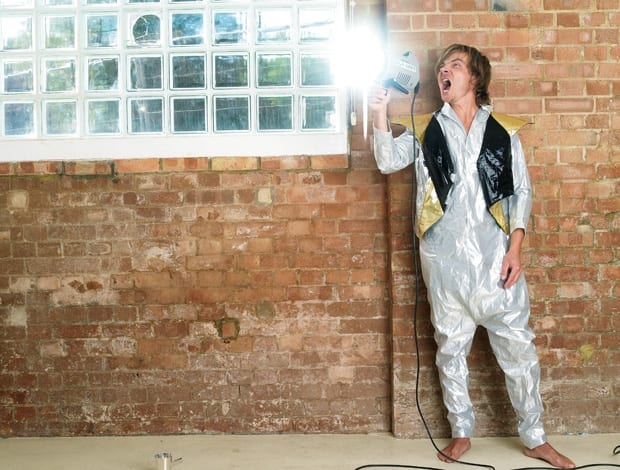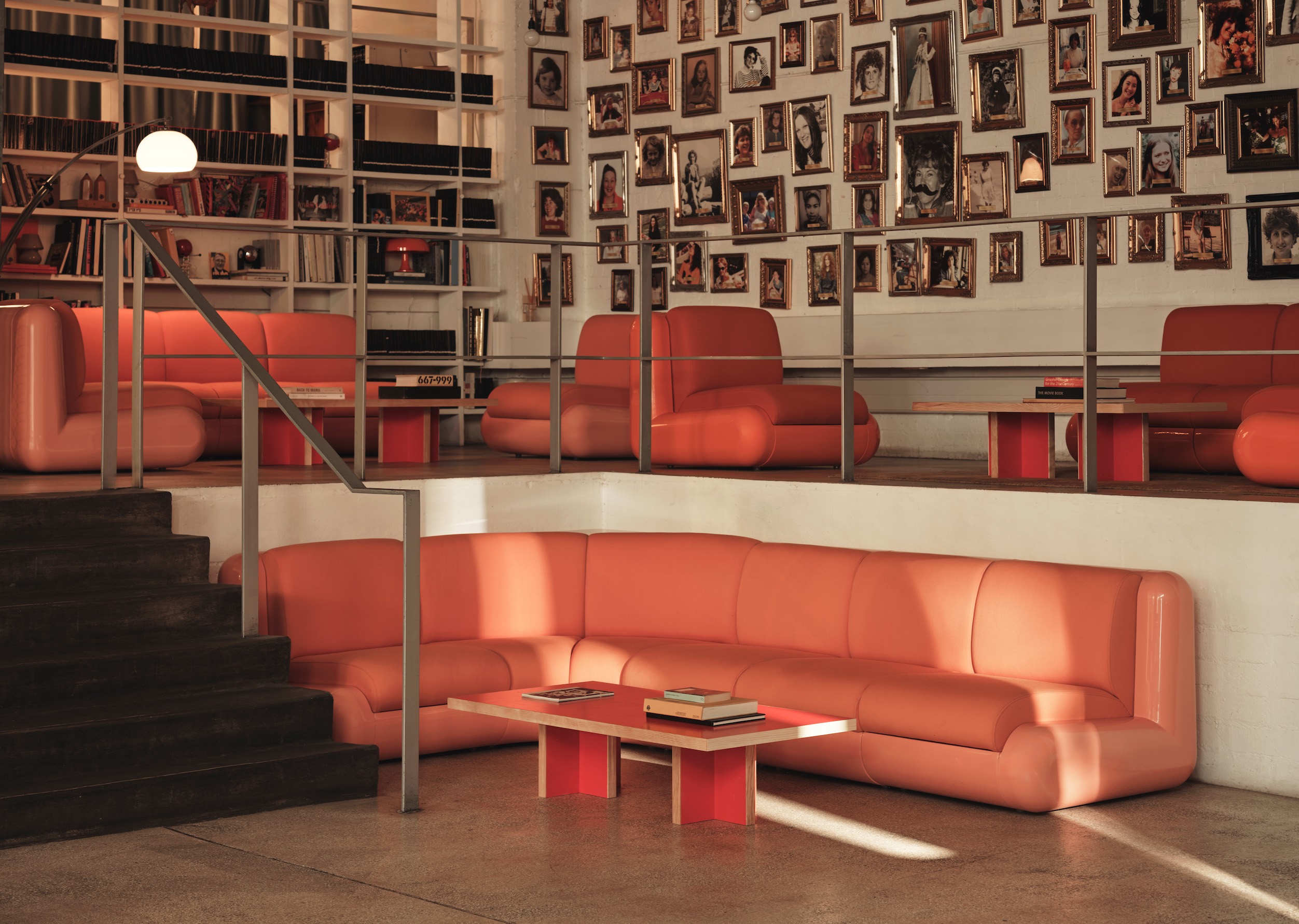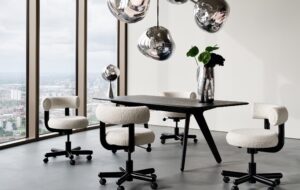 Bram Boo: the designer who thinks that “many people don’t want to work: they also want to play”|Bram Boo in his workshop, an hour outside of Brussels, working on a prototype of the Overdose chair|The designer takes inspiration from everyday things, such as slabs of concrete stacked up on a building site|The Salsa Range (2005); Boo is currently in talks with Vanerum to develop these for the contract furniture market|The Gypsy Things (2004): fantastical furniture that gives a hint of the surrealism to come|The newly released Overdose desk (2009)|Backstage storage cupboard (2008)|Tete a Tete table (2002)|Paparazzi task chair (2008)|Overdose chair (2009), whose ‘halo’ of storage compartments was inspired by paintings of saints|the Lazy desk (2008) – where the day’s work can be deftly swept into the side compartment, ready for fun|Little Boo in cowboy boots alongside his father, Dutch abstract painter Bram Bogart|Boo and his sister’s playroom: his vibrant, artistic childhood home has proved an enduring influence|Boo’s childhood bedroom||
Bram Boo: the designer who thinks that “many people don’t want to work: they also want to play”|Bram Boo in his workshop, an hour outside of Brussels, working on a prototype of the Overdose chair|The designer takes inspiration from everyday things, such as slabs of concrete stacked up on a building site|The Salsa Range (2005); Boo is currently in talks with Vanerum to develop these for the contract furniture market|The Gypsy Things (2004): fantastical furniture that gives a hint of the surrealism to come|The newly released Overdose desk (2009)|Backstage storage cupboard (2008)|Tete a Tete table (2002)|Paparazzi task chair (2008)|Overdose chair (2009), whose ‘halo’ of storage compartments was inspired by paintings of saints|the Lazy desk (2008) – where the day’s work can be deftly swept into the side compartment, ready for fun|Little Boo in cowboy boots alongside his father, Dutch abstract painter Bram Bogart|Boo and his sister’s playroom: his vibrant, artistic childhood home has proved an enduring influence|Boo’s childhood bedroom||
Fusing functionality with humour and fantasy, the Belgian designer’s work speaks a language all of its own. As he lets loose a typically surreal range of office furniture, Elizabeth Choppin meets him
Is there a more gleeful name than Bram Boo? It’s the stuff of fairytales, where inanimate objects have been known to walk, talk and break into choreographed dance routines. It seems appropriate then that the Belgian furniture designer has lived up to his name and created cupboards, desks and task chairs worthy of an office-themed version of Alice in Wonderland.
Even more fitting is that a Belgian, coming from the land of Magritte and Delvaux, has come up with what might be the world’s first surrealist office furniture. Needless to say, Boo’s is not the usual approach to workplace design – and good on him for stirring the pot.
“It’s good to see something in a different way,” he offers, when we meet to discuss his current exhibition at Galerie Revolt’s in Paris. “I try to feed my ideas with functionality at the start and then come on to something else that is very special. It’s a way of showing that we don’t have to follow the rules.”
Boo’s designs are indeed functional, but the overwhelming impression of his new Overdose desk, with its cluster of storage boxes like gaping mouths, is not of function but of fantasy. There is a magical quality to his pieces, which when grouped together resemble a timber menagerie of little creatures. One almost expects the tables and chairs of The Gypsy Things range, with their curious geometrical dimensions, to make honking noises and trot away.
It’s a refreshing change from the utilitarian, back-to-basics approach dictating design these days, and certainly gives food for thought as to why almost all office furniture ends up looking and feeling one particular way. Why do desks and chairs in workplaces have to be so serious? Why can’t they be silly or joyful or not at all what you’d expect? It may seem trivial on the face of it – but in fact these are questions that possibly should have been asked a long time ago.
Can office furniture encourage us to dream, to fantasise or to think? Have we been missing a trick somewhere? The Lazy desk, for example, which Boo completed in 2008, is all about balancing work with fun. Oversized compartments on each side of the table invite the user to clear work away at the end of the day with a swoop of the arm.
“Many people don’t want to work, they also want to play, and with this desk you create fun because, in our system today, you’re working for your freedom. And so it’s a desk where, voila!, you are free again,” he chuckles.
This idea of freedom is something that can be traced back to Boo’s childhood. Born in Brussels in 1971 to the well-known abstract painter Bram Bogart and mother Leni, also an artist, memories of being a carefree little boy are very potent in Boo’s work. The house he grew up in holds a kind of folklore – the brightly coloured paintings, the bonkers modern furniture made especially by designer friends, the discussions about art.
“I’m a mix of two strong cultures. My parents are Dutch, they always talked about Dom Hans Van Der Laan and those people, but I’m born in Belgium, it’s a country of surrealism, so I think I’m a mix. I’ve got the constriction of the Dutch, but there is also a Belgian part that is not too serious. I start furniture with that function and then move on to the other things – it’s a blend of a Dutch and Belgian way to see things, perhaps.”
“When people first see my furniture in a space, perhaps they should laugh a little bit. That’s very important to me”
This tension is evident in the Overdose desk, which follows the Overdose chair, presented at the Prophets & Penitents exhibition in Milan this year.
“It’s a response to my own desk, full of chaotic stacks of documents, but chaos is quite nice in a way because it is dynamic. I thought I should make it more ordered, but I wanted to keep that charming disorder, and then the idea of the boxes came.”
It seems that growing up the son of a well-known painter was both a blessing and curse for Boo – there was a lot of freedom (it wasn’t enforced that he should go to school from the ages of 14 to 18), but there was also a lot of pressure, and it was difficult for him to find his own talents while in the shadow of his father’s success.
At age 12, the problems began.
“I was a trouble-maker. I couldn’t follow the normal way of going to school, to go inside a room and do these things all day; for me it was too much after living in that very rich, very full world of my parents. I escaped and started having very dark years. When I was 17, my father said, ‘Bram, things are going bad with you. If you’d like to come work with me, you can.’”
Slowly Boo’s love for furniture developed as he worked for his father and took night classes in carpentry. In 1997, at the age of 25, he started “very late” at the Royal Academy of Art in Hasselt, Belgium, and ever since has steadily established a fantastical design language all his own.
For someone who loves to make such poetic, sculptural pieces, it is extraordinary that Boo is so interested in designing for the office, but he feels it is the most exciting terrain because of the sheer amount of time spent at work. He wants to challenge people to reconsider their habits – almost like doing a double-take.
“People are used to seeing a table-like table, and may be a little disturbed by what I do,” he says. “I’m playing with function and it creates a kind of emotional response to something. When people first see my furniture in a space, perhaps they should laugh a little bit, that’s very important to me. They may work another way because the furniture is something a little bit strange, but they might do it with new inspiration. In the office, it’s very important to have that.”
This is all very well and good of course, but the reality is that for every progressive piece of office furniture, there is a risk-averse facilities manager who is more than happy to buy off the peg. Many of Bram Boo’s designs are at prototype stage or are limited edition objects. But, as we’ve seen with the work of Tomas Klassnik for YCN (as featured in September’s onoffice) and Nothing Amsterdam (featured in the June issue), there is a real push for bespoke design solutions in the office, especially when budgets are tight. It seems that underground designers are delivering these with a great deal of originality and impact, and its here that Bram Boo could really make a mark.
“I do something in the way I love to do it, but then I know it’s possible to make it in a more industrial way”
In fact, some of Boo’s products have been put into mass production, and at the moment, contracts are very nearly in the bag with several more European manufacturers – so his designs are not just theoretical folly. The Oasis couch for Drisag, which has two changeable seating elements intended for rest and work, has been a huge success. White Nun, a lacquered steel and aluminium stackable chair, was put out by Unic in 2007, and Boo is in talks with contract furnishing company Vanerum to adapt his Salsa range for break-out spaces.
“I’m a very busy man these days! I love it,” Boo exclaims.
A deal is also under way with a big Italian brand (very hush-hush) to develop his Backstage storage cupboard and he is negotiating with a Belgian company, FELD, which produced his Etcetera table in 2004, about how to make the Paparazzi task chair (a plywood prototype with jauntily placed boxes, introduced in Milan), “more comfortable”, i.e. commercially viable. So, as wacky as his products are, Boo isn’t precious about tweaking them to jive with the needs of a potential commercial client. It’s all part of the story, he says, and let’s face facts – a designer needs to make a living.
“I do something in the way I love to do it, but then I know it’s possible to make it in a more industrial way,” he explains. “It’s exciting because you see an object which is a little bit original, and people love it and they say ‘ok, we’re going to try to translate it.’ I love the freedom to make something and see which companies will be charmed by it.”
What Boo isn’t keen on doing, it appears, is designing pragmatically for a gap in the market. His work is unusually emotional and inspired by personal experiences whereas so many designers work from briefs. Far from seeming self-indulgent though, Boo just comes across as particularly honest.
“It’s not so easy to talk about what you are doing and why you are doing it,” he admits. “You can say yes, I have to do something serious for the industry, but I don’t really work that way. Industry is coming, or not, because I’m doing something of my own,” he adds. “Being a designer was a way to find myself and to enrich myself. When I was younger, I loved excitement more than normal, and I got into trouble, and perhaps you can find that in my furniture today. Maybe it’s a way to find excitement in life but with more positive result. It’s quite personal.”
In this sense, Boo might be considered more of an artist than a designer. His work extends beyond function or beauty and into ideas and philosophy, plus he hasn’t tried to disguise that furniture design has been his salvation. It’s a division that he is aware of: “When people tell me that what I am doing looks like art, I respond by telling them they have the choice to place it where they want to place it. For me, it’s just what I do and never mind if it’s art or design. It’s just creation – but function is the main part of my creativity, and I guess that’s why we can say it’s design!” And he lived happily ever after…



















